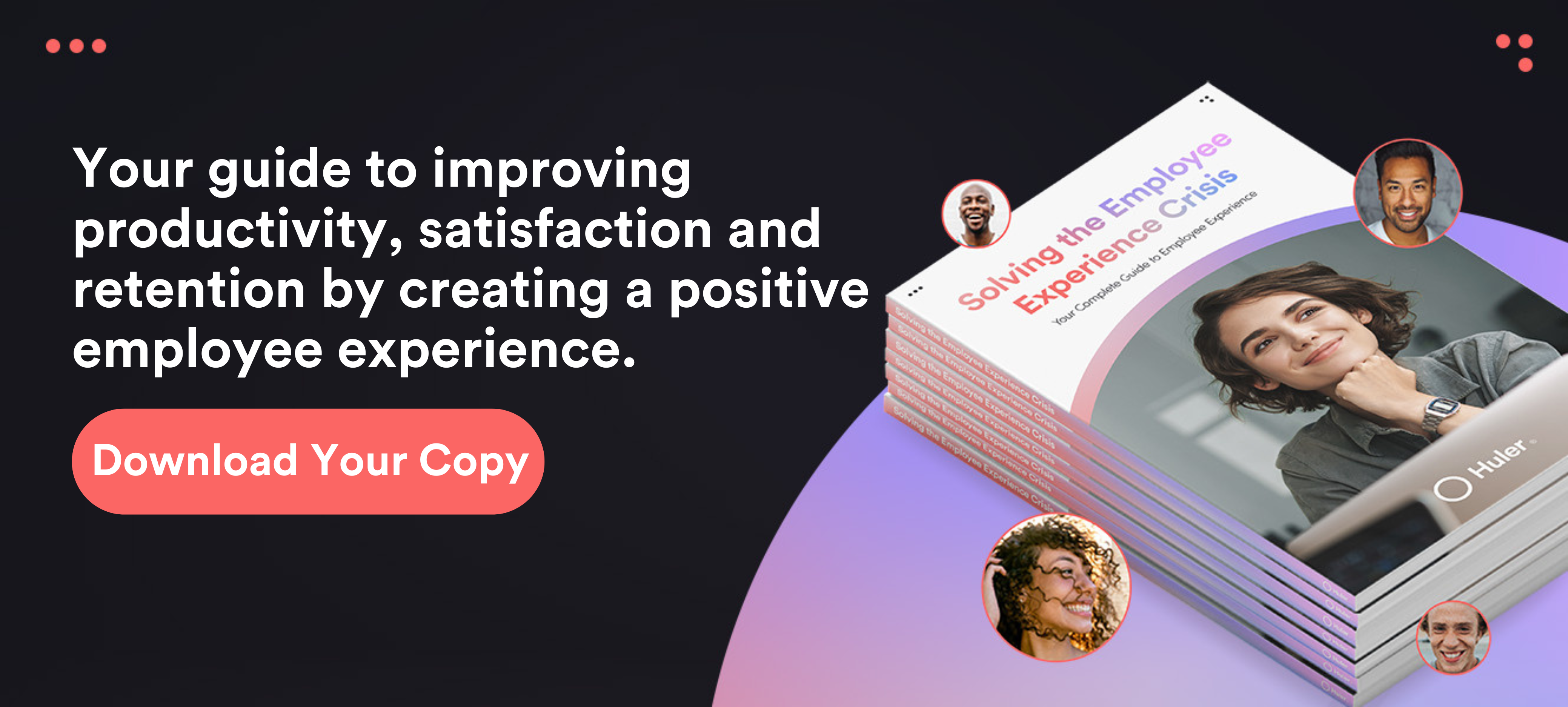While many definitions of employee empowerment refer to the term as an action undertaken by a business, the truth is that employee empowerment is a feeling. When someone feels empowered, they possess “the knowledge, confidence, means, or ability to do things or make decisions” for themselves.
Employee empowerment refers to how employees feel when they have everything they need to work autonomously and excel within their role. The opposite of this is when an employee feels they aren’t seen, heard, or given the power to work effectively for them, leading to low engagement.
Why does this matter? Well, according to Gallup’s State of the Global Workplace report, employee engagement decreased globally from 22% in 2019 to 20% in 2020. What’s more, disengaged employees can cost US companies up to $550 billion per year. That is a huge price to pay for not investing time, effort, and money into employee engagement. Conversely, engaged team members are proven to be more present and proactive, resulting in 21% greater profitability.
Employee engagement is essentially a measurement of how motivated, passionate, and invested your workforce is. It can be affected by many factors such as location, culture, and the individual. It can also be influenced by how empowered employees feel in their job, and within a business.

Examples Of Employee Empowerment
Many real-world organisations are upping their game when it comes to empowering their employees. Let’s take a look at some examples and explore why they are so effective.
Timpsons
Timpsons, is one of the UK’s largest retailers and is known globally for its employee engagement efforts. A quick look at their Careers page gives us a great insight into why this is.
Timpsons considers all of their employees’ as part of the family and says that ‘looking after them is [their] number one priority.’ They do this by offering a comprehensive training scheme for all staff from day one, promoting from within, and being a true equal opportunities employer (they are the biggest recruiters of ex-offenders in the country).
On the empowerment front, Timpson’s takes an ‘upside down’ approach to management:
“All of our colleagues have total authority to do whatever they need to do to amaze our customers”
They also conduct an annual ‘happy index,’ where employees are encouraged to share what they really think about the business, how it is run, and how they feel they are treated.
Disney
Disney’s commitment to looking after their employees starts with their mission statement:
“The Walt Disney Company entertains, informs and inspires people around the globe through the power of unparalleled storytelling, reflecting the iconic brands, creative minds, and innovative technologies families have come to love for over 90 years.”
The company goes to great lengths to put employees and cast members at the heart of everything they do, starting with a benefits package that includes career development and community involvement opportunities, childcare options, paid time off, tuition assistance, and access to wellness programs.
They are also committed to diversity and inclusion, holding Business Employee Resource Groups that give a platform for employees to offer their time, expertise, and cultural insights to improve the workplace and innovate in the marketplace.
Google offers employees a range of fantastic staff benefits and incentives range from onsite wellness and healthcare services and fitness centres to flexible working hours. However, real employee empowerment happens underneath the surface of this global organisation.
One of the most talked-about employee empowerment initiatives are their Google Cafes. These are locations where different teams are encouraged to meet, share ideas, interact in order to break down workplace silos and promote across-team collaboration.
Googlers also have the freedom to spend 20% of their time pursing personal projects; an initiative that has given rise to a number of notable Google products such as Gmail, Google AdSense, Google News, and Google Maps!
What Can We Learn?
In all of the above real-world examples, we can identify a fundamental pattern. For employee empowerment to be effective, organisations must commit to a culture of openness, transparency, communication, and (above all else) trust.
If you don’t trust your employees to use their best judgement or pour their passion into innovative pet projects, then there is no way you can harness the benefits of employee empowerment.
How Does Employee Empowerment Work?
Empowering employees essentially comes down to understanding what drives them. Reward and punishment are long-standing motivational strategies in the average workplace. That is: if you do X, you will get Y. But this simplistic approach fails to take into account what really motivates your people.
In his book, Drive: The Surprising Truth About What Motivates Others, author Daniel Pink uses behavioural science to challenge common misconceptions around motivation. He argues that the traditional ‘carrot and stick’ approach is outdated. Instead, we have entered ‘Motivation 3.0’, whereby individuals in the workplace are motivated because they have the freedom to work in a way that suits them.
This approach uses intrinsic motivation, where individuals do something because it is enjoyable or interesting, rather than because of an outside incentive (extrinsic motivation).
When an employee is empowered, they are intrinsically motivated. They have autonomy, and a sense of purpose, which motivates them to perform.

3 Components of Employee Empowerment
Employee empowerment embodies three key factors: autonomy, mastery, and purpose.
Autonomy
A 2019 study revealed that 52% of employees lack autonomy. Yet, when given the freedom to work autonomously, we are more creative, innovative, and productive. What’s up with that?
Autonomy is an essential psychological human need. In the workplace, it means giving employees what they need to succeed and letting them do that in ways that work for them. It is the exact opposite of micromanagement, which implies a lack of trust.
Of course, there are different levels of autonomy, which depend on a range of factors. The main thing is that employees have a degree of choice over when, where, and how they do their job.
Leaders might find this concept scary. But empowering your employees with autonomy can result in:
- Increased employee engagement
- Higher motivation
- Better performance
- Improved productivity
- More innovation
Mastery
Your employees want to learn and get better at their jobs (around 86% of employees say that job training is important to them). They get a sense of innate satisfaction when they master a task or do something well, so much so that a large majority of employees are willing to learn outside of work to improve their job performance.
It is no secret that upskilling your staff means they get better at their jobs. But there is more at play here than simply being more knowledgeable. When an employee sees their employees investing in them, they feel even more intrinsically motivated to achieve.
Along with training and continuous learning, mastery can also be achieved through stretching and challenging. That is, giving employees more responsibility and asking them to do more complex tasks.
That doesn’t necessarily mean throwing them in the deep end to see if they swim. Instead, it should be a gradual process whereby leaders pass on more and more responsibility to employees (along with the training and tools they need). Doing this allows for learning on the job, upskilling, and an increased sense of empowerment as employees continue to push forward.
Purpose
Employees disengage when they don’t understand the ‘why’ behind their role, or they can’t see themselves in the bigger picture.
In a study published by Harvard Business Review, researchers found that more than 9 out of 10 employees are willing to trade a percentage of their lifetime earnings for greater meaning at work. They also discovered that employees who find their work very meaningful are more satisfied.
As humans, we all have a desire to be a part of something bigger than ourselves. Our work is no exception. That is why organisations have mission statements and core values – to create a culture employees (and customers) align with.
For employees to feel empowered they need to have a sense of purpose . When they do, they feel passionate, innovative and committed to serving their organisation. Conversely, when a person does not have this sense of purpose, they are more likely to be actively disengaged and not in alignment with the values, mission and overarching goals of the company.
Challenges To Employee Empowerment
But, like anything, it’s not always easy to bring about employee empowerment for several reasons. Let’s explore a few:
Manager Push Back
Undoubtedly, there will be swathes of managers out there who hate the idea of employee autonomy. To them, it spells DANGER in big red flashing lights. This is due to a lack of trust and confidence, both of which are unproductive feelings within a workplace.
To combat this, more preparation is needed to shift to an employee empowerment model. That might start with letting employees structure their workday from a list of pre-defined tasks. Or adopting hybrid work practices by offering the opportunity to work remotely or from anywhere.
Over time, as managers gain trust and confidence in their employees, further steps can be taken to empower employees with more responsibility and autonomy.
Lack of Effective Training
Empowering employees doesn’t mean running roughshod over company policies and procedures. Quite the opposite. Instead, comprehensive training and clear policies are required to make it work.
There are some areas where employers simply can’t afford to slip up, such as GDPR and data protection. But that shouldn’t mean you should put the brakes on letting your employees do their thing.
Your employees should have access to the most up-to-date training and information in order to thrive. They also need to know the boundaries in which they can work. Empowered employees move freely within their role and make informed decisions with the help of support and guidance from leaders.
Lack Of Communication
A common challenge to employee empowerment is a lack of communication. Sometimes, managers think that, because they have given workers the freedom to do their own thing, they don’t have to communicate with them. This is simply not true!
If we think back to our intrinsic motivators, clear and concise communication is key to success.
A huge 97% of workers believe that communication impacts tasks daily. What’s more, over a quarter of employees cite poor communication as the reason for not being able to deliver work on time.
Lack of communication leads to disconnection, low productivity, and inefficient work processes.
Regardless of your role or what you do, communications should be transparent, relevant, and regular. That can range from internal communications (like remote working policies) to more focused communications between managers and employees in the form of appraisals or feedback.
4 Ways You Can Empower Your Employees
Share Your Vision
Imagine that someone asks you to get in a car and drive. But they don’t tell you where or why. How would that make you feel? Lost, confused, and not very motivated, we bet!
The same thing happens when companies don’t share their vision with their employees. Although they know they have to do something, they don’t know why, which leads to a disconnect.
Instead, make a point of communicating your vision with employees. Help them to understand their contribution to the journey and make them feel excited about doing it as a part of your organisation.
According to Gallagher’s State Of The Sector 2021 report almost half of the organisations surveyed plan to implement culture change in 2021. That means a full shake down and change up of values, behaviours and leadership styles intended to boost employee empowerment, experience and engagement.
Have Clear Boundaries & Expectations (Yes, Really!)
Boundaries and expectations aren’t prisons. They are parameters in which employees have the freedom to work. For example, in customer service, you might give your employees a budget they can use to satisfy customer complaints, or a ‘goodwill’ pot which employees can use at their discretion.
In both cases, employees have an area in which they can use their common sense and discretion. Doing this doesn’t give employees free rein to give out free products, nor does it leave them feeling helpless and reliant on managerial approval to do a good job. Win, win!
Create Two Way Communication Channels
Feedback is super effective at helping employees grow in confidence. This goes beyond giving feedback at prescribed moments, like one-to-ones and appraisals. It boils down to creating a culture of feedback that spans the whole hierarchy of your business.
According to Hubspot, 69% of employees would work harder if they felt their efforts were better recognised. Simply put, recognition makes your employees feel more motivated to work harder. As does having a platform to share their feedback and ideas.
A recent State Of Employee Ideas Report also found that around 30% of employees think their ideas are being ignored by their employers, while a large majority of junior employees also reported they are fearful of voicing their ideas in the workplace.
For employees to be empowered, they should be recognised, heard, and listened to. Without those three crucial elements, they are much more likely to disengage and underperform.
Give Employees A Voice
A recent survey found that 72% of American employees wish their boss or manager would give them more responsibility. This (perhaps surprising) statistic shows that motivating employees isn’t necessarily the biggest problem, it’s empowering them with more responsibility and autonomy.
Including employees in decision-making is a great way to start with this. Doing this helps them to forge a deeper connection with the company culture, their role, and their contribution.
The Benefits Of Employee Empowerment
Employee empowerment fosters a sense of trust in leaders, motivating employees, facilitating creativity, and boosting employee retention. All of which results in heightened growth for companies of any age or size.
A Motivated Workforce
In a 2019 global poll, Gallup found that, out of one billion full-time workers, only 15% are engaged. Meaning that a whopping 85% of people are actively disengaged.
Empowering employees through autonomy, mastery, and purpose increases both motivation and engagement. Why? Because employees are intrinsically motivated to work hard and do a good job, which no amount of carrot dangling can compete with.
Increased Trust
Trust is fundamental in any relationship. In the workplace, leaders must trust their employees – and vice versa. While taking steps to empower employees can feel scary at first, once established it builds trust. And it’s not just a one-way street either. If employees feel empowered and supported, they are more likely to trust their leaders and get on board with new ideas and initiatives.
Similarly, when employees are allowed to shine and do their best work, bosses and managers can feel secure in letting them get on with it in a way that works for them, safe in the knowledge that it will benefit the overarching goals of the business.
More Creativity & Innovation
We’ve mentioned before how Google lets employees spend 20% of their time working on their own projects. And perhaps we should take a leaf out of their book. After all, they are one of the most forward-thinking, globally successful businesses out there.
Creativity doesn’t flourish in rigid, rule-driven environments. If your employees don’t have the freedom to work on projects that spark thier passion, they’re unlikely to innovate beyond their daily duties.
Empowered employees are committed to meaningful goals; therefore, they think outside of the box, push boundaries, and flourish. They are also more likely to go above and beyond in their working day because they feel supported too.
Final Thoughts
In our opinion, all organisations and businesses should be doing more to empower employees. Not only for their bottom lines but to support employees to bring their best selves to work.
No matter your sector or size, employees are the driving force to success, growth, and innovation. Without them, there is no business to run.
With that in mind, why would you not want to give them the power to present authentically, be themselves, and flourish within your organisation?
True employee empowerment starts with listening to your employees. What do they need? What do they want? What slows them down? What excites them? And that’s just the beginning.
When you truly understand what sparks a fire in the hearts and minds of your workforce, you can begin to use that to tap into their intrinsic motivation levels. You encourage them to use creativity and innovation to solve problems, take accountability for their work, and feel proud of their achievements. Most of all, you instil a sense of purpose in them, which can’t be reached just by dangling a carrot and hoping for the best.
Here at Huler, the prospect of businesses the world over harnessing the power of their people’s passion, innovation and drive to succeed is a truly exciting prospect. To that end, we create digital workplace platforms and solutions that help you harness that power and use it for the greater good. To find out more about how we do what we do, check out HulerHub and request a demo, our plug and play digital workplace platform built to drive employee engagement by making everything your teams need to succeed accessible in 2 clicks or less!





